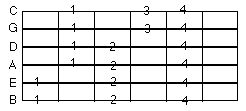HYBRID
INTERVALLIC APPROACHES
Last time around I introduced you to some intervallic approaches
to playing scale forms. These included intervallic 2nds, 3rds, 4ths,
5ths, 6ths, and 7ths. Hopefully, these exercises are helping you to
implement a method of phrasing that sounds less like ëscale practiceí
and more like melodies. In this article, we will take fragments from
my last article and combine them together into new hybrid intervallic
approaches.
Intervallic practice is quite beneficial to us as players because it
trains our ears to recognize more ëangular-soundingí melodic shapes
and forms, as opposed to pure scalar movement. For a lot of players,
the shapes that they are able to recall based on what they are spontaneously
hearing are limited to a small group of patterns that have been practiced
independently of their performance situations. In other words, the shapes
that they can play ëby earí are limited to simple exercises that sound
like rehearsed patterns and not much more, simply because that is what
they have spent hours repeating over and over again in the practice
shed. Because of this, it is necessary that we constantly push the envelope
of our current level of ear training and phrase recognition. This means
forcing ourselves to learn to play and hear shapes that we are not familiar
with already. You will find that the better you are at recognizing intervals,
the faster you will be able to transcribe more challenging lines or
learn complex phrases by ear. Subsequently, you will also gain the ability
to recall these more advanced shapes spontaneously, both on the gig
and in critical recording situations.
For the following examples, we will refer again to our reference major
scale pattern that we have used in previous articles, using a 3 note
per string position, as demonstrated in previous columns. The fingerings
are given for 4 string, 5 string, and 6 string bass in figs. 1a.-1c.
Fig. 1a

Fig. 1b

Fig. 1c

The following examples will utilize the range of a 4 string bass, using
a G major scale pattern played in a single position. (Start the pattern
on the 3rd fret E string.) Remember to keep your hand in position as
shown, using only the fingerings specified for the duration of each
exercise.
Method 1: Combining 2 intervallic shapes
Using this method, we take two intervals and combine them together into
one exercise, alternating the interval off of each scale degree in order.
Top
Example
1a: Combining 6ths and 3rds
In this example, we alternate playing an intervallic 6th and an intervallic
3rd off of each successive scale degree. The exercise written in scale
degrees would look like this:
Ascending: 1-6, 2-4, 3-8, 4-6, 5-10, 6-8, 7-12, 8-10
Descending: 12-7, 11-9, 10-5, 9-7, 8-3, 7-5, 6-1, 5-3
Ex. 1a
 *
*
Example 1b: Combining 3rds and 5ths
In this example, we alternate playing an intervallic 5th and an
intervallic 3rd off of each successive scale degree. The exercise written
in scale degrees would look like this:
Ascending: 1-3, 2-6, 3-5, 4-8, 5-7, 6-10, 7-9, 8-12
Descending: 12-10, 11-7, 10-8, 9-5, 8-6, 7-3, 6-4, 5-1
Ex. 1b

Example 1c: Combining 4ths and 7ths
In this example, we alternate playing an intervallic 4th and an
intervallic 7th off of each successive scale degree. The exercise written
in scale degrees would look like this:
Ascending: 1-4, 2-8, 3-6, 4-10, 5-8, 6-12
Descending: 12-9, 11-5, 10-7, 9-3, 8-5, 7-1
Ex. 1c

Top
Method
2: Combining 2 consecutive intervals
Using this approach, we would first choose an interval and then
play it twice, consecutively, from each scale degree. This can also
be referred to as the ëstackingí of intervals.
Example 2a: Playing 2 consecutive 5ths
In this example, we play an intervallic 5th off of each scale degree,
and then another intervallic 5th above that. The result is a 3 note
grouping off of each scale degree created from the stacking of 2 intervallic
5ths. The exercise written in scale degrees would look like this:
Ascending: 1-5-9, 2-6-10, 3-7-11, 4-8-12
Descending: 12-8-4, 11-7-3, 10-6-2, 9-5-1
Ex. 2a

Example 2b: Playing 2 consecutive 3rds
In this example, we play an intervallic 3rd off of each scale degree,
and then another intervallic 3rd above that. The result is a 3 note
grouping off of each scale degree created from the stacking of 2 intervallic
3rds. (This is the same idea as playing a diatonic triad off of each
scale degree.) The exercise written in scale degrees would look like
this:
Ascending: 1-3-5, 2-4-6, 3-5-7, 4-6-8, 5-7-9, 6-8-10, 7-9-11, 8-10-12
Descending: 12-10-8, 11-9-7, 10-8-6, 9-7-5, 8-6-4, 7-5-3, 6-4-2, 5-3-1
Ex. 2b

Top
Example
2c: Playing 2 consecutive 4ths
In this example, we play an intervallic 4th off of each scale degree,
and then another intervallic 4th above that. The result is a 3 note
grouping off of each scale degree created from the stacking of 2 intervallic
4ths. The exercise written in scale degrees would look like this:
Ascending: 1-4-7, 2-5-8, 3-6-9, 4-7-10, 5-8-11, 6-9-12
Descending: 12-9-6, 11-8-5, 10-7-4, 9-6-3, 8-5-2, 7-4-1
Ex. 2c

Obviously, these are just a few of the many possibilities for integrating
hybrid intervallic approaches into your practice routine. You will find
that the more you push yourself to learn the shapes and sounds of these
types of examples, the more creative you will become in improvisational
contexts. Furthermore, the angular shapes of these exercises will likewise
challenge you technically. If you practice these at a variety of tempos
in a disciplined fashion, your speed and dexterity will also improve.
You might also want to try these using different types of techniques.
For example, try mixing together a slap and fingerstyle approach to
playing each of these. You might be pleasantly suprised by what you
come up with. Until then, happy practicing!
Top